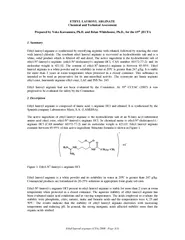

D and Brian Whitehouse PhD for the 69 th JECFA 1 Summary Ethyl lauroyl arginate is synthesized by esterifying arginine with ethanol followed by reacting the ester with lauroyl chloride The resultant ethyl lauroyl ar ginate is recovered as hydrochlori ID: 84899
Download Pdf The PPT/PDF document "Ethyl lauroyl arginate CTA Page ETHYL..." is the property of its rightful owner. Permission is granted to download and print the materials on this web site for personal, non-commercial use only, and to display it on your personal computer provided you do not modify the materials and that you retain all copyright notices contained in the materials. By downloading content from our website, you accept the terms of this agreement.
C l Ethyl lauroyl arginate (CTA) 2008 - Page 2(5)Ethyl lauroyl arginate has been evaluated for food safety as antimicrobial in food by the U.S. Food and Drug Administration (FDA) in 2005, and as a food preservative by the European Food Safety Authority (EFSA) in 2007. The synonyms are lauric arginate ethyl ester, lauramide arginine ethyl ester, LAE and INS No. 243. 3. Manufacturing The method of manufacturing is described in European Patent No.1294678. The starting materials employed for the manufacture of ethyl lauroyl arginate are -arginine HCl (CAS 1119-34-2), ethanol (CAS 64-17-5), thionyl chloride (CAS 7719-09-7), sodium hydroxide (CAS 1310-73-2), lauroyl chloride (CAS 112-16-3) and deionised water (CAS 7732-18-5). LAMIRSAs patented production process consists of two steps followed by a filtration process.The first step of production concerns the esterification of the carboxyl group of -arginine HCl with ethanol, using thionyl chloride as an esterification agent and exploiting the heat of reaction in order to carry out this reaction. The final product obtained in this step is the ethyl arginate 2HCl. The second step of production involves the condensation of lauroyl chloride with the -amino group of ethyl arginate 2HCl in an aqueous medium. The last step in the production process of ethyl lauroyl arginate is the filtration of the reaction mixture through a press filter to separate out the final product obtained via the reactions described above. Once the filtration process is finished, the resulting product is a white solid with a content of water from 11.5 to 18.6% and a content of the active ingredient between 71% and 81%. This product is stored at refrigeration temperatures inside a stainless steel container and it may be dried to produce ethyl lauroyl arginate with a content of the active ingredient between 85 and 95% and a water content Ethyl lauroyl arginate is stored at refrigeration temperatures and inside a stainless steel holding tank. The manufacturing process of ethyl lauroyl arginate has been validated, according to GMP, from the product obtained at the end of the first part of the synthesis, ethyl arginate 2HCl, to the production of the product before being dried which has a content of active ingredient 71-81%. The equipment involved in this validation process was the reactor of the second process of synthesis and the filter press. 4. Characterization 4.1 Physicochemical characterization The physicochemical properties of ethyl lauroyl arginate are shown Table 1. They are tested by the EEC methods for the Determination of Physicochemical Properties, Directive 92/69/EEC, Part A, Methods A1-A17 and the OECD Guidelines for the Testing of Chemicals. Ethyl lauroyl arginate (CTA) 2008 - Page 3(5)Table 1. Physicochemical Properties Ethyl lauroyl arginate is soluble up to 20% in propylene glycol, glycerin and ethanol. The pH of 1 % aqueous solution is the range of 3.64 to 4.25 on 4 batches. 4.2. Chemical characterization The chemical characterizations of 6 batches of ethyl lauroyl arginate are shown at Table 2. Ethyl-N-lauroyl--arginate HCl is the active ingredient of ethyl lauroyl arginate and its contents are 88.1-90.3%. Possible impurities are residual materials, by-products and others. Lauric acid, -arginine HCl and ethanol are materials and their residual amounts are 2.3-3.0%, 0.1-0.4% and 0.2%, respectively. NLauroyl--arginine, ethyl laurate and ethyl arginate 2HCl are by-products and their contents are 1.5-2.3%, 1.0-2.0%, 0.01-0.4%, respectively. Other three minor by-products (P2, P3 and P4) share the structure of ethyl-N-lauroyl--arginate HCl but have an additional lauroyl group. Impurities P2 and P4 should be in a ratio smaller than 1% and 0.5%, respectively. P3 is 0.064% in a batch. Water contents are 0.9-4.1%. Ashes heated at 700° are mainly NaCl and their amounts are 0.7-1.5%. Arsenic, cadmium, lead and mercury are not detected. Ethyl lauroyl arginate (CTA) 2008 - Page 5(5)European Patent No. 1294678 held by Lamirsa. Abbreviated description: Process for the preparation of cationic surfactant products composed of an esterified amino acid and a fatty acid linked by an amide bond to the amino group of the amino acid.